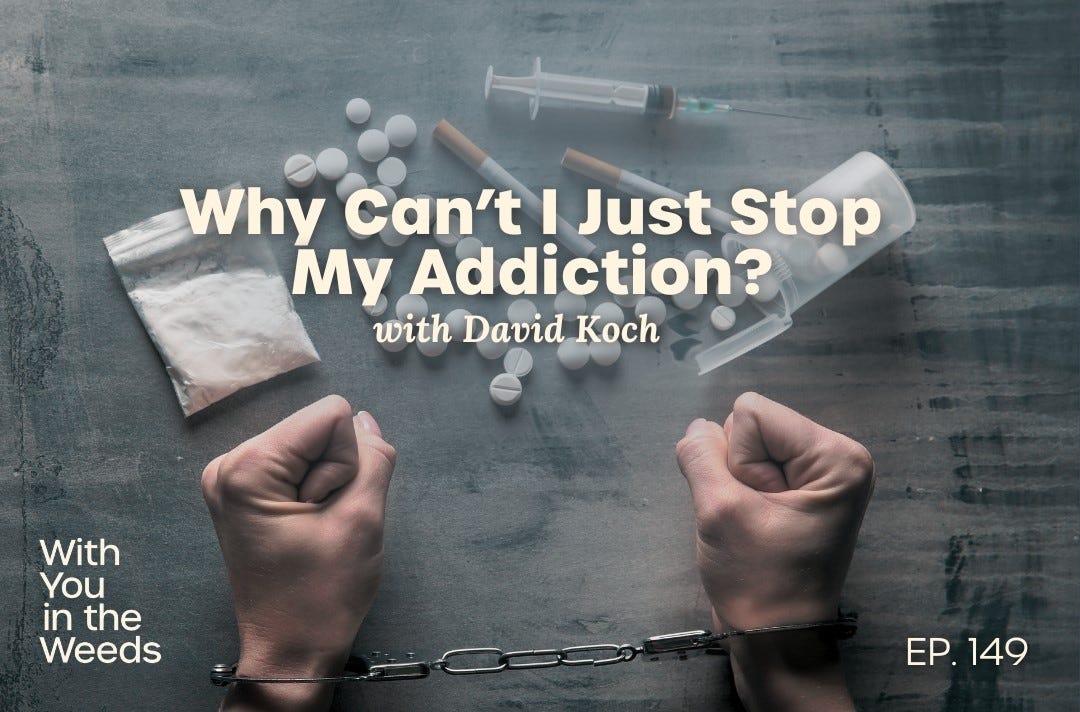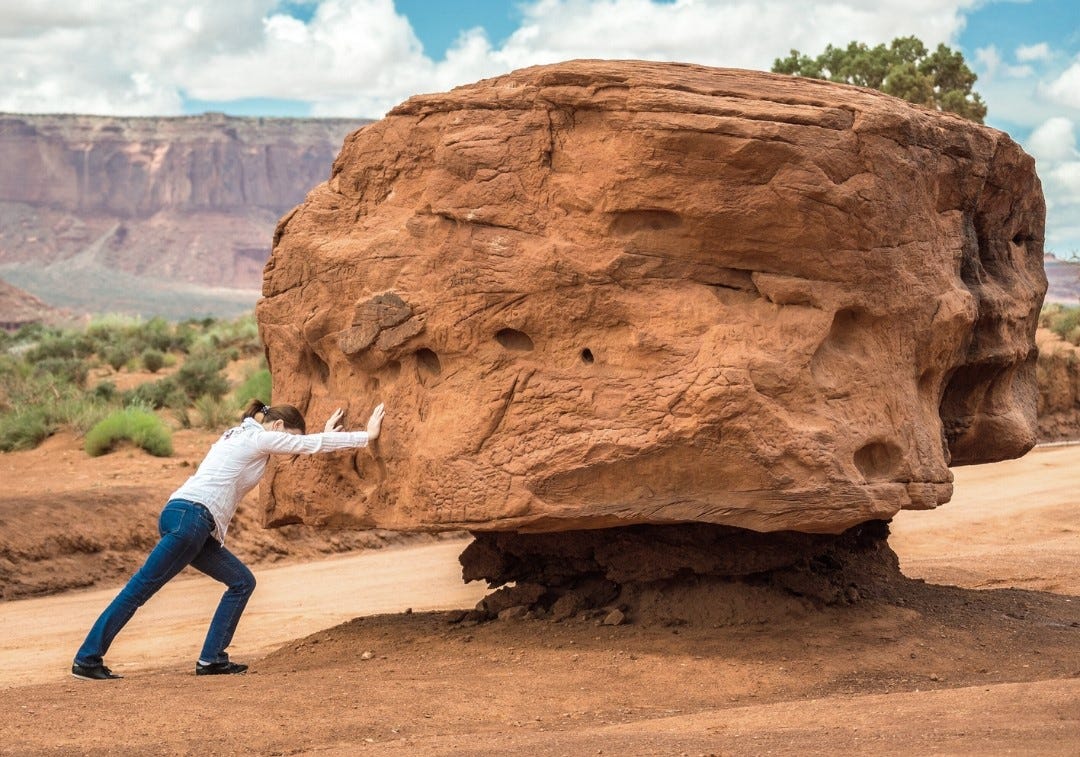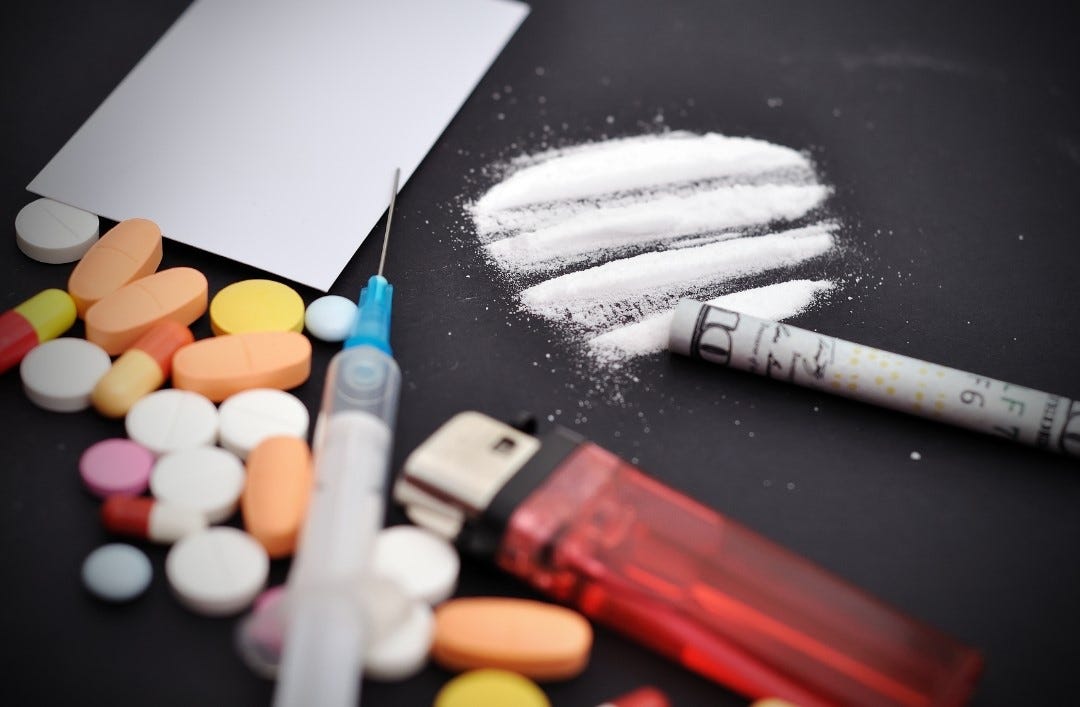Why Can't I Just Stop My Addiction?
The realities that make quitting difficult
If you’ve ever tried to stop your dependence on drugs or alcohol, you may have found yourself even more tightly bound than before. And yet you never set out to become an addict. Is there any hope, or are you doomed to your addiction forever?
In this perceptive episode of our ongoing series, Dealing with Your Addictions, Austin sits down with David Koch, a licensed professional counselor, certified sex therapist, and director of program operations at Crossroads Counseling Centers in St. Louis, Missouri. David also teaches on addictions and brings both professional expertise and personal vulnerability to the conversation.
Together, Austin and David explore the realities of addiction—what it is, how it develops, the role that contributing factors play, and why recovery is such a complex and often painful journey.
David will give you a behind-the-scenes look at:
What’s going on in someone’s life before an addiction starts
The chemical ways that addiction affects the brain
How someone can recover from an addiction
Shattering myths about addiction
Whether you’re personally wrestling with addiction, walking alongside someone who is, or simply wanting to better understand this issue, this conversation offers honesty, hope, and practical insight.
It turns out that struggling with addiction doesn’t make you a failure—it just means the healing part of your story hasn’t been written yet.
Highlights of Austin’s Interview with David
A Personal Path into Addiction Counseling
Austin: Today I’m interviewing one of my grad school professors, David Koch, who is the director of program operations at Crossroads Counseling Centers in St. Louis, Missouri. He’s a licensed professional counselor and a certified sex therapist. The addictions class he taught at Covenant Seminary was a two-week intensive class. The class was engaging, and he was thoughtful and honest and vulnerable.
David, thanks so much for being here with us today. What’s life looking like for you these days personally and professionally? How did you find yourself in the role of an addictions professor?
David: I’m really grateful and delighted to be doing this with you today. I have a wife and three kids. What we’re doing at Crossroads keeps me pretty busy. Besides counseling, we offer holistic care to the communities we are serving, including spiritual direction, nutrition, and mindful movement.
As far as becoming a professor of addiction, that was kind of an accident. I didn’t even take a class on addiction in grad school. But when my wife was pregnant I took the first job I could get. It happened to be at a methadone treatment center about five minutes from my house. I asked mentors in the field, “What do you think?” They said, “You’ll learn a lot about counseling and a ton about addiction.”
I hopped from that job into working with adolescents and then working at a hospital and realized along the way, oh, I’m an addict. So part of what God was doing was exposing my own brokenness. One of the things that qualifies me to do addiction work well is that I understand the struggle of the people I work with.
The Spectrum of Addiction
Austin: If you’re in the throes of addiction right now or working with someone who is an addict, you’ve probably asked, or been asked the question, “Why can’t I just stop?” We’re going to get to that, but let’s start with a definition. David, how would you define addiction?
David: While you could ask 10 different experts and get 10 slightly different definitions, I think the main thing is it’s a habitual pattern of behaviors that increase over time to create a stronger issue down the road.
When we talk about capital ‘A’ addiction, it involves serious consequences in someone’s life. It becomes more established over time. It can go on for months, years, or even decades. The addiction impacts their minds, their bodies, their emotions, their relationships, and their careers.
Then there are lowercase ‘a’ addictions that we probably all struggle with, where the consequences aren’t as devastating and we’re able to be high-functioning most of the time. The path of lowercase ‘a’ addiction is often more of a psychological dependence and capital ‘A’ is physiological. With lowercase ‘a’, we like having it around. With capital ‘A’, we must have it.
Austin: What about the genetic and epigenetic factors? Is there some sort of test that can tell you if you’re more likely to be an addict or not?
David: Before someone becomes entangled in addiction, they have free will and they have choices. At the same time, they may have genetic, cultural, or environmental factors that may lead them in a certain direction. Something I say is, “Addiction is rarely the problem, but often a poor solution to a bigger problem”. With folks on the capital ‘A’ addiction path, there is often significant trauma in their story. Trauma and shame are like a heavy backpack weighing them down and affecting their choices.
In the late 80s and early 90s, people began studying the effects adverse childhood experiences (ACEs) including abuse, neglect, substance abuse or mental illness in the household, parental separation or divorce, violence in the home, and incarceration. People who had high numbers of ACEs had a significant correlation with many addictions, and also a greater likelihood of physiological and psychological issues.
On the flip side, I’ve worked with alcoholics and addicts who come in and say, “I feel bad because I don’t have capital ‘T’ traumas in my story. I shouldn’t have an addiction. What’s wrong with me?” They don’t realize the devastating effect of lowercase ‘t’ traumas, especially when piled up over time. So you may have to use a really curious lens to figure out someone’s story.
From Relief to Ruin—The Stages of Addiction
Austin: Let’s move to when someone is in the throes of a full-blown addiction. What’s going on?
David: The Jellinek Chart is one resource I point people to a lot. It’s a chart developed by a physician who studied alcoholism. He created a model of the way the disease took effect. At the very beginning is experimentation or “relief drinking”. The drink you have at the end of a stressful day.
The second thing that happens at that early stage is that you start to feel shame about it. And then you hide it. I would say that’s the transition point in the process of developing an addiction. There are more stages of addiction as it progresses, and at the end of the Jellinek Chart, the addiction starts taking things away from you, whether that’s your job, your money, your relationships, or your health.
There are some important things that impact the process of developing an addiction. Frequency of use is a really important factor. Then there are differences in how addictive a drug is, and also the route you use to take it—orally vs intravenous vs inhalation makes a difference as well. It also makes a difference how readily available something is.
If you want to look at the study that is most noteworthy with this, it’s pornography. Sex addiction did exist back in the ‘80s and ‘90s, but if you look at all the statistics, it blew up in cataclysmic amounts with two things: the invention of high-speed internet access and the smartphone. Both of those have made porn so much more accessible and available and it really doesn’t have a whole lot of cost in a lot of cases, hence the sharp increase in pornography addiction.
On one hand, every addiction is a little bit different. On the other hand, there really is a common factor between all addictions and the person caught in the addiction, which is that it’s very difficult to stop. Maybe they stop for a few days, maybe they start to see things clearly, but recovery takes a long time. It’s not as simple as realizing you need to stop or even stopping for a time.
Addiction and the Brain
Austin: Let’s get into the neuroscience of it. How does addiction affect the brain?
David: Our understanding of this has increased greatly over the years. Dopamine was once thought to cause pleasure, but it functions more like a “save button,” teaching the brain to seek repeated experiences. Over time, tolerance develops as receptors change. Different drugs affect the brain in distinct ways:
Alcohol – Enhances dopamine by acting on opioid and GABA receptors, producing an initial buzz that requires more over time.
Marijuana – THC stimulates, CBD relaxes; modern THC is far more potent than in past decades.
Nicotine – Directly triggers dopamine release between brain cells.
Cocaine – Blocks dopamine reuptake, keeping dopamine active longer and causing intense stimulation.
Methamphetamine – Triggers dopamine release and blocks reuptake, making it especially powerful and damaging.
Overall, these substances affect dopamine differently, but all of them hijack the brain’s reward system, inviting repeated and increased use to feel the effects of the drug. This makes substance addiction very difficult to recover from.
The Journey of Recovery
Austin: Let’s get into that, David. How does somebody recover from an addiction?
David: There’s a model called the trans-theoretical model where they studied alcoholics and saw that there were stages that people went through. The first stage is basically not knowing that it’s a problem. At some point though, and this is where a lot of people will come to therapy or treatment, they know that it’s a problem, but they understand that recovery is really costly in terms of personal effort.
It takes a lot in order to treat an addiction. When people are in the early stages of trying to treat this, a lot of times what we see is people going back and forth between addiction and recovery. The word for that is ambivalence. For many people, the addiction has been the most consistent thing in their life for years. The reality of being human means it’s possible to love something and hate it at the same time.
For many people, the addiction has been the most consistent thing in their life for years. The reality of being human means it’s possible to love something and hate it at the same time.
Treating shame is maybe the most important element of treating an addiction. You will rarely find someone who’s very far into an addiction and hiding it who is not experiencing significant shame. There’s a spiritual piece to this, like the Bible verse that says ‘Jesus went to the cross despising the shame’. But it’s not enough just to know that; you actually have to feel it as well.
If someone you care about is struggling with addiction, listening to their story without judgment is so valuable. Addiction comes with the territory of being human. So providing a space for people to be seen and heard helps break the shame.
Shattering Myths About Addiction
Austin: Can you share some addiction myths and what you would say to destroy those myths?
David: Probably the biggest one is that drugs cause addiction. That is not true. They are part of the process, but if you look at research that has been done, it’s really clear drugs are not the problem. But unfortunately, culturally, we’ve made those the problem.
Another myth is that confronting the addict is the best practice. I strongly discourage people from confronting people by saying, “You’re an addict.” People are often surprised that I almost never tell someone they’re an addict. One, it’s not a diagnosis. It’s a self-assessment. And two, having someone put a label or a term on you when you’re struggling rarely leads to insight. It ratchets up the shame.
Austin: What is a better way to approach someone struggling with addiction?
David: Share some of the concerns that you have about them or their situation. Gently mention things you’ve observed. Ask them why they like their drug. That may seem like an endorsement, but many addicts have never had someone ask them that and it opens the door for further conversation.
Another myth is that addicts are responsible for becoming addicts. I tell people that addicts are 0% responsible for becoming an addict. I have never met someone who said, “I want to become an addict.” Most of the time, people don’t know the addiction warning signs or their personal risk factors.
I’m not saying someone’s not responsible for what they do. AA says we’re not responsible for our disease, but we’re responsible for our recovery. This is a hard message for family members to hear. The flip side is also true. It’s not the family’s fault that people become addicts either. There are factors impacting people that are beyond the family’s responsibility.
Someone in the throes of an addiction still has dignity and value. Some of the most amazing people I have met in my life have had significant struggles with addiction. It strips away pride. If people can make it through to the other side, it can have a remarkable impact on their hearts, even if behaviors continue to be a struggle.
Inviting God’s Love Into Our Wounds
Austin: David, thank you so much for being with us and sharing your wisdom. Would you mind praying for our listeners and whoever might come across this podcast?
David: Father, I think one way of reading the Gospels is watching you, Jesus, move toward a very broken world. You went into Samaritan land to talk to the woman at the well—a woman who was morally corrupt not only by their standards but even modern-day standards. You engaged her with so much love and kindness that she turned around and ran back to her village to tell them what had happened. That’s your heart.
Father, I ask for all of us, but in particular those who are in the throes of an addiction, that you would give us a sense of your love and how much you want to heal our wounds and minister to us.
Father, I pray that you would help all of us as believers to be a part of that, that we would be able to minister to the hurting world around us. You are the God who is gracious and loving and slow to anger and ultimately wanted to die so that we could have life. Thank you for that. I pray these things in your name, Jesus. Amen.
Austin: Amen. Thank you, David.







